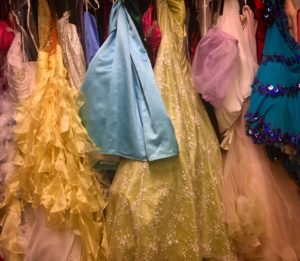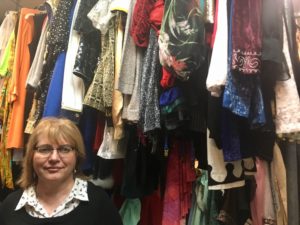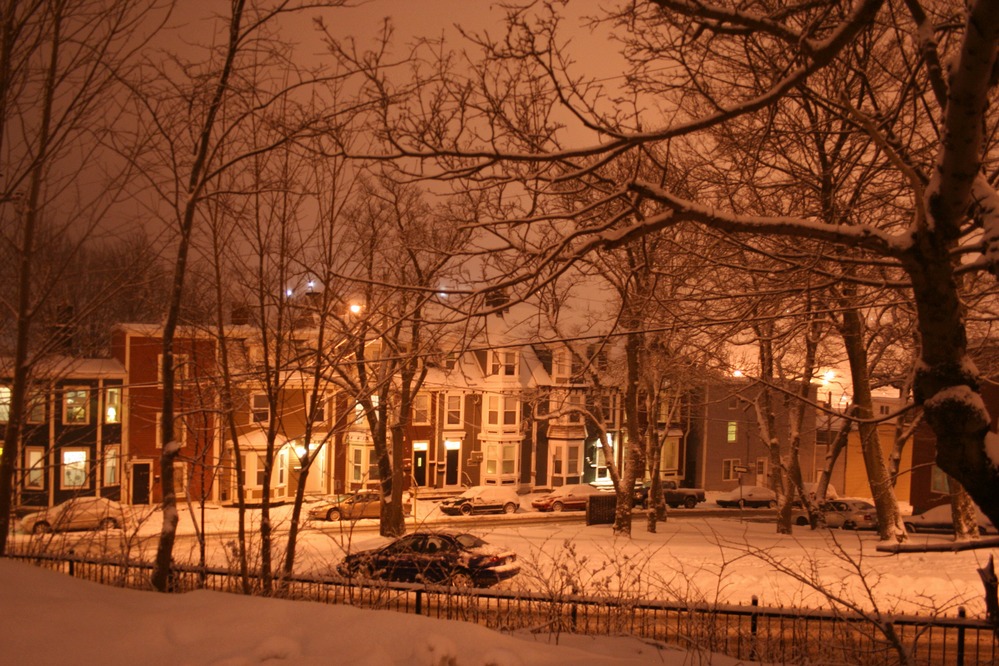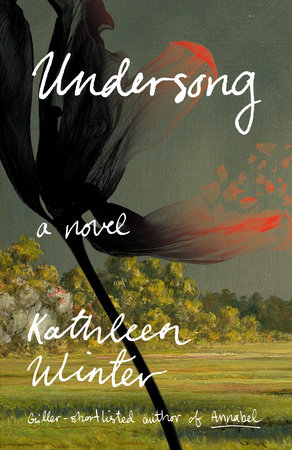Costume Banks and Conjured Worlds
BY Eva Crocker
June 2018

Photo by Eva Crocker.
Costume banks are in-between spaces, part of both this world and the imagined world of plays. I’ve never worked in theatre but as a writer I’m invested in the power of inviting people into fictional worlds. I’ve always been fascinated by costume banks as vestibules between this world and an invented one.
As teenagers, my friends and I used to skip class and hang out in the costume bank at Holy Heart of Mary High School. The room was in an annex above the theatre, at the end of an abandoned hallway littered with broken desks. We would sneak around the back of the school to smoke a joint and then into the costume bank, where we’d spend a couple periods petting the crinolines and trying on extravagant hats, giggling and hushing each other.
The bell that marked the end of class would echo through the room, an intrusion of the outside world into our private hideaway. The bell always startled us, we’d freeze and listen to hundreds of rubber-soled sneakers slapping the hallway, making their way from one class to the next. The costume bank felt like CS Lewis’s wardrobe; in amongst the old coats was this secret world that was inside the school but separated from the structure of the scheduled school day.
I was recently in the basement of the St John’s Arts and Culture Centre and happened to walk by an open door to the Centre’s Costume Bank. The room was so tightly packed that I would have had to wheel a rack of costumes into the hallway to fit between the tuxedo shirts and floor-length gowns that filled the doorway. I could feel a weird energy that I remembered from the Holy Heart costume room emanating from the doorway; a mixture of world-building possibility and ghosts of shows past.

Deborah Clarke
Deborah Clarke, the Costume Supervisor at the St John’s ACC, generously agreed to give me a tour so I could soak in more of that eerie energy. On the day of our interview, I found Clarke in her sewing room where she was distressing a piece of burlap attached to the body of a human-sized spider hung on a mannequin.
In Clarke’s sewing room there is a library of research books on the back wall, next to a floor-to-ceiling shelving unit overflowing with fabrics, some folded and some stuffed between the shelves. Buttons, strings of sequins, spray bottles of paint, and the occasional wig are strewn over sewing stations. Any wall that isn’t occupied by shelving is covered in a collage of patterns for costumes and bits of fabric thumbtacked in place.
“Some people might think, ‘how can you work in all this chaos,’ but I always say ‘if it’s not chaotic you’re not being creative,’ because out of chaos comes some of the most brilliant things,” she said.
The Centre’s Costume Department supplies costumes to theatre, film, and television productions all over the Island. Depending on the size of a production there will sometimes be three or four people working in the sewing room with Clarke; other days she is there on her own. In the sewing room Clarke and the other costume artists alter existing costumes and build entirely new ones. Clarke also helps producers find what they are looking for in the Centre’s enormous collection of stored costumes.
The Costume Bank spans about nine rooms, scattered throughout the basement of the Centre, and houses thousands of costumes. Clarke led me through a maze of concrete tunnels, bending to unlock doors with a set of keys she wore around her neck. The rooms are arranged by wardrobe; suits of armour are clustered together and children’s tailcoats are hung together, tupperware bins of authentic 1940s and 1950s undergarments are stacked together. Clarke knows where to find everything.
As we weave through the racks she tells me the history of specific pieces, like a donated Sherlock Holmes’ style cape and deerstalker hat that was worn during the Boer War. Each costume is a talisman for transformation and picking the right one can help summon a character, conjure a world.
After the tour I rode an old-fashioned service elevator up out of the belly of the ACC. I kept checking my phone to see if I had reception; I was dying to tell my partner about my afternoon. On the sunny front steps of the building four bars lit up the screen but I hesitated before dialling. I felt like Dorothy crashing back down in Kansas or Alice hurled up the rabbit hole – how to describe the wild place I’d just visited.



